Building a Healthier North Dakota
By Jena Pierce on
If there was a theme for the 39th Annual Dakota Conference on Rural and Public Health, it would be "How to Build a Healthier North Dakota." In 1990, North Dakota was the healthiest state in the nation according to America's Health Rankings. In 2023, North Dakota was ranked 14. The vision for North Dakota Health and Human Services (HHS) is to once again earn that prestigious top spot and become the healthiest state in the nation. Again.
Strengthening Health Workforce
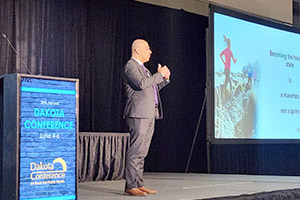 A large part of
building a healthier state requires a strong health
workforce, with a pipeline for future providers and
employees. And efforts can't just focus on physical
health, but must include behavioral health and economic
health initiatives, according to Dr. Nizar Wehbi, the
state health officer of North Dakota who oversees North
Dakota HHS. His keynote address, North Dakota Public
Health Vision, was one of four keynotes at the conference
and was sponsored by the North Dakota Public Health
Association.
A large part of
building a healthier state requires a strong health
workforce, with a pipeline for future providers and
employees. And efforts can't just focus on physical
health, but must include behavioral health and economic
health initiatives, according to Dr. Nizar Wehbi, the
state health officer of North Dakota who oversees North
Dakota HHS. His keynote address, North Dakota Public
Health Vision, was one of four keynotes at the conference
and was sponsored by the North Dakota Public Health
Association.
Health workforce was a hot topic at the two and a half day statewide annual conference. Many of the sessions, intensives, and Dr. Wehbi's address focused on how to recruit and retain the needed workforce, now and in the future.
Pulling from Across the World
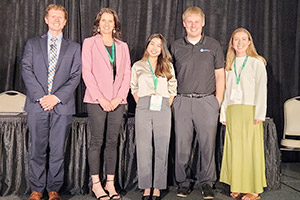
Kusler, Alzandra Carmona, Brock Sherva,
and Paige Kuntz participated in a
workforce panel.
During the workforce panel discussion about immigrant staffing, Brock Sherva, CEO of Northwood Deaconess Health Center (NDHC), shared the challenge of hiring positions for the health center. "There are several hospitals close together in proximity, and we realized we can't keep trying to steal employees from each other. We need to find a way to bring in more people to help fill these needs," he stated.
NDHC decided to look for an employee from overseas to fill a lab tech position. Alzandra Carmona was educated in the Philippines and wanted to work in the U.S. Both Carmona and NDHC worked with international staffing agencies, and each had to decipher the complexity of work visas and learn the ins and outs of the options available to them.
There are several hospitals close together...we realized we can't keep trying to steal employees from each other. We need to find a way to bring in more people to help fill these needs.
Sherva received three applicants from the Philippines. After virtual interviews, they offered the job to Carmona. She accepted. Four months later, she relocated to Northwood utilizing a work visa.
It has been a positive experience for both Sherva and Carmona, and NDHC is working to bring in additional international staff in the future. This is a trend slowly happening across the state.
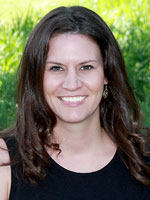
Stacy Kusler is the workforce specialist for the Center for Rural Health (CRH) and also works closely with the primary care office. She moderated the panel. "Hiring non-U.S. workforce should be viewed as a strategy rather than an obstacle."
Kusler's office manages the J-1 Visa program. "One way to use immigration as a strategy is to utilize the J-1 Visa waiver program for physicians. Many of the 30 waivers go unused every year and they are a valuable tool to increasing the skilled provider workforce."
Building a Workforce Pipeline
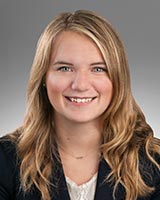
One of the intensives at the conference explored how to address public health workforce needs in North Dakota. The presenters focused on exposing youth to potential careers in healthcare and public health to get them to start thinking about what they want to be when they grow up. Brittany Dryburgh, project coordinator at the North Dakota State Office of Rural Health (SORH), spoke about the Rural Collaborative Opportunities for Occupational Learning in Health (R-COOL-Health) Scrubs Program. CRH houses SORH and two workforce programs geared specifically toward youth.
Scrubs Camps are focused on rural students in grades 5-12, take place in the rural communities, and require partnerships between schools, healthcare facilities, and economic or job development authorities. Each camp looks a little different but often features local career options available in rural healthcare fields, including nursing, pharmacy, lab and radiology, public health, and more.
There are also two Scrubs Academies. These are four day/three night camps held in bigger cities. Scrubs Academy I is held at the University of North Dakota (UND) and is open to students who will have completed grades 6-8. This summer, the academy will be held at UND June 17-20. Students participate in hands-on activities and receive information related to a variety of healthcare professions. In addition to the experiences with healthcare professionals, students are certified in Friends and Family CPR and the Health Insurance Portability and Accountability Act (HIPAA).
Scrubs Academy II is being held within the Devils Lake community July 29 – August 1 and is open to students who will have completed grades 9-11. Students will spend their days in various health facilities (Critical Access Hospitals, tertiaries, clinics, long-term care and assisted living facilities, ambulances, treatment centers), enjoy fun activities in the evenings, and spend the night in the Lake Region State College dorms. Students have the opportunity to job shadow multiple professions during the course of the academy.
Dryburgh shared that she has heard stories that students who once attended a camp or academy and went on to earn their Certified Nursing Assistant certification. One student went to Northland Community & Technical College in East Grand Forks, Minnesota, and earned an associate's degree in nursing. She is currently a registered nurse working in Grand Forks. Anecdotal stories like these show filling the pipeline with potential employees is working and allows students to dream about creating a career in the rural communities where they grew up.
Cassandra Schock, administrator of Nelson-Griggs District Health Unit (NGDHU) in McVille, can attest to the power of Scrubs Camps. NGDHU was asked to partner with Nelson County Health Center on a camp three years ago, and they continue to partner every year. The partnership has been worthwhile and the students are getting to know about the different careers available, not only at the hospital but at the clinic and NGDHU. For their part of the camp, Schock says they are focusing on injections on oranges, but are also educating about the vaccine life cycle.
Ideas and Innovations
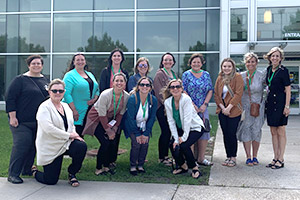 Another session at the Dakota Conference focused on
artificial intelligence in predicting and preparing
staffing. An additional panel featured three state
legislators who discussed health policy at the
legislative level. Blue Zones
Grand Forks hosted a session on their program
supplemented by a walk to promote physical activity and
social wellness at the end of the second day of the
conference. Blue Zones focuses on helping people live
better, longer. Enhancing quality of life is important in
the recruiting and retaining of staff and their families.
Another session at the Dakota Conference focused on
artificial intelligence in predicting and preparing
staffing. An additional panel featured three state
legislators who discussed health policy at the
legislative level. Blue Zones
Grand Forks hosted a session on their program
supplemented by a walk to promote physical activity and
social wellness at the end of the second day of the
conference. Blue Zones focuses on helping people live
better, longer. Enhancing quality of life is important in
the recruiting and retaining of staff and their families.
Dr. Wehbi shared the State Health Improvement Plan (SHIP), which is a five-year cycle plan (2021-2025). There are four areas:
- Strengthening workforce
- Cultivating wellness
- Expanding access and connection
- Building community resilience
A steering committee is being developed to receive input from various stakeholders and communities are being asked to share their ideas as well.
We know that different communities have different needs and require different strategies to address those challenges.
Dr. Wehbi talked about the Statewide Health Strategies grants that just closed at the end of May. "These grants are geared to spur local innovations that work for the communities. We know that different communities have different needs and require different strategies to address those challenges."
Whether it is in a rural hospital, a local public health unit, at a university, or through a state department, everyone's goals are to create a healthier place to live. It takes not just a village, but an entire state of people, with differing approaches, working toward the same goal: building a healthier North Dakota.


 is the communications manager at the Center for Rural
Health at the University of North Dakota School of
Medicine & Health Sciences in Grand Forks.
is the communications manager at the Center for Rural
Health at the University of North Dakota School of
Medicine & Health Sciences in Grand Forks.



